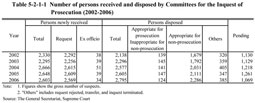| Previous Next Index Image Index Year Selection | |
|
|
1 Grievance system against non-prosecution
The right to prosecute is exclusively granted to public prosecutors. Public prosecutors are also granted broad discretion upon prosecution. However, a public prosecutor may misjudge a case and make a decision of non-prosecution against a suspect who should be prosecuted. For this reason, legal procedures have been established for the relief of complainants, victims and others against the disposition of non-prosecution by a public prosecutor. Under this system, it is allowed to request reviews by the Committees for the Inquest of Prosecution and to file applications for committing a case to a competent district court for trial (also called the quasi-prosecution procedure).
(1) Request for reviews by Committee for the Inquest of Prosecution A total of 201 Committees for the Inquest of Prosecution are established nationwide, each comprised of 11 members chosen by lot based on an electorate list for a term of six months. By request or ex officio, a Committee reviews the disposition of non-prosecution made by a public prosecutor and make a judgment of the case being “appropriate for prosecution”, “inappropriate for non-prosecution” or “appropriate for non-prosecution.” Furthermore, the Act for Partial Amendment to the Code of Criminal Procedure etc. (Act No. 62 of 2004) partially amended the Act for the Inquest of Prosecution (Act No. 147 of 1948). The amendment introduced a system where public prosecution can be instituted based on a decision of the Committees for the Inquest of Prosecution under certain circumstances. The part of this act pertaining to this system is scheduled to be enforced by May 2009 (see Part 6, Section 5). Table 5-2-1-1 shows the number of persons received and disposed by the Committees over the last 5 years. Table 5-2-1-1 Number of persons received and disposed by Committees for the Inquest of Prosecution (2002-2006) In 2006, the Committees newly received 2,360 persons for penal code offenses. By type of offense, the greatest number of them (462 persons) were received for causing death or injury through negligence in the pursuit of social activities, followed by 363 persons for counterfeiting of documents, 338 persons for abuse of authority, 254 persons for injury, and 150 persons for fraud (Source: The General Secretariat, Supreme Court).Table 5-2-1-2 shows subsequent measures taken by public prosecutors for the cases judged by the Committee to be appropriate for prosecution or inappropriate for non-prosecution, by reason of initial disposition of non-prosecution, over the last five years. Table 5-2-1-2 Subsequent measures for the cases judged by the committees to be appropriate for prosecution or inappropriate for non-prosecution by reason of initial disposition of non-prosecution (2002-2006) A total of 148,374 persons were disposed by the Committees between 1949 (when the Act for the Inquest of Prosecution took effect) and 2006, including 17,062 persons judged to be appropriate for prosecution or inappropriate for non-prosecution. Among them, prosecution was instituted for 1,355 persons, and 1,204 were convicted (420 sentenced to imprisonment and 784 to fine) and 78 were found not guilty (including dismissal for judicial bar and dismissal of prosecution) (Source: The General Secretariat, Supreme Court).(2) Request to commit a case to a court for trial The request to commit a case to a court for trial is the system that allows accusers or complainants, who are dissatisfied with the public prosecutor's disposition of non-prosecution for various types of abuse of authority, to request a competent district court to commit the case to trial. The district court renders a ruling on whether or not to commit a case to trial depending on whether such request is well grounded. Based upon such ruling, the case shall be regarded as if a public prosecution was instituted and the court shall appoint an attorney who shall maintain the public prosecution from among privately practicing attorneys and have him/her perform his/her duties. In 2006, the number of persons for whom the requests were made in this way was 243 and the number of persons for whom such rulings were made was 476. Commitment of the case to a court for trial was not decided for any of these cases (Source: Annual Report of Judicial Statistics and The General Secretariat, Supreme Court). |

